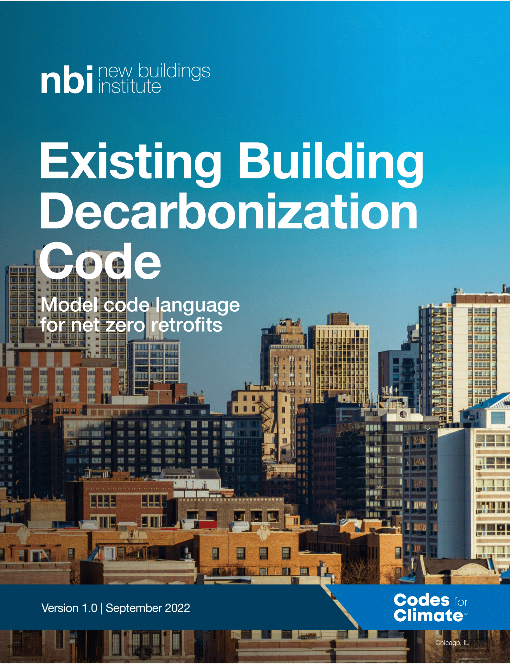Posted by Brianna Crandall — September 23, 2022 — New Buildings Institute (NBI) has released the Existing Building Decarbonization Code, a new way for jurisdictions to reduce carbon emissions and meet climate action plan goals and interconnected goals around public health and equity. The need to address existing building stock is immense, notes NBI, with 5.9 million existing commercial buildings in the U.S. comprising 97 billion square feet. New construction represents less than 2% of building activity in any given year, leaving a vast opportunity to update technologies in the current building stock. By requiring existing buildings to be more energy efficient, cities could cut about 30% of all urban emissions by 2050.
 NBI’s February 2020 release of the Building Decarbonization Code provided the first off-the-shelf solution for jurisdictions to transform energy codes into decarbonization codes for new buildings. Expanding where that document left off, the new Existing Building Decarbonization Code adds provisions specifically for existing buildings. The new model language covers both residential and commercial buildings, including all-electric and mix-fuel energy use pathways.
NBI’s February 2020 release of the Building Decarbonization Code provided the first off-the-shelf solution for jurisdictions to transform energy codes into decarbonization codes for new buildings. Expanding where that document left off, the new Existing Building Decarbonization Code adds provisions specifically for existing buildings. The new model language covers both residential and commercial buildings, including all-electric and mix-fuel energy use pathways.
“As policymakers are seeking solutions to drive carbon emissions reductions in existing buildings, their current options are limited,” said NBI’s Director of Codes Kim Cheslak. Rather, they look primarily to benchmarking and disclosure policies and building performance standards (BPS) that address the actual performance of existing buildings. “Provisions in the Existing Building Decarbonization Code for needed energy efficiency, system-by-system electrification, and onsite renewable energy generation can be integrated with, or used in place of, jurisdictional BPS policies to aid in overall building sector decarbonization and energy use reductions.”
For existing buildings, every replacement should be treated as an opportunity to reduce energy use and carbon emissions by optimizing systems and electrifying equipment, says NBI. The code provisions in the overlay have been crafted to match reasonable and effective decarbonization strategies with replacement events. The code outlines strategies to pair key opportunities to decarbonize — including change of occupancy, additions and alterations — with additional efficiency measures to create buildings that achieve additional benefits from the all-electric pathway.
The Existing Building Decarbonization Code also incorporates trigger events and solutions for the inclusion of grid integration measures including renewable energy production, electric vehicles, and battery storage. Targeting these technologies will allow existing buildings to support a healthier grid. By selecting optimized lifecycle events for the mandatory installation of these technologies, buildings will benefit from the lowest cost retrofit solutions.
Both the all-electric and mixed-fuel paths restructure Chapter 5 of the International Energy Conservation Code (IECC) to improve usability generally and to make it easier to incorporate new measures for decarbonization provisions.
The Existing Building Decarbonization Code includes provisions for:
- Efficiency: Existing buildings were built to a variety of previous codes, and many do not perform as well as new construction, including those that have been updated over time. Provisions that require strategic, opportunistic efficiency improvements are critical to get the existing building stock decarbonized.
- Renewable energy: This provision requires a roof replacement project to be paired with the installation of an onsite renewable energy system. Roof replacements provide an advantageous opportunity to install an onsite renewable energy system such as a photovoltaic (PV) array.
- Electric vehicle (EV) charging: There are several building life cycle events that support the addition of EV charging to existing sites or the addition of electrical infrastructure to support future EV charging retrofits.
- Energy storage: New attached and detached garages provide an ideal location for energy storage systems in residential construction. This provision requires energy storage readiness that meets the requirements of the Building Decarbonization Code be included in these projects.
The mixed-fuel provisions only partially electrify building systems, allowing hybrid systems that utilize both electricity and natural gas. Jurisdictions are not limited to using either the electrification or mixed-fuel paths in their entirety. Rather they can select only a subset of the sections from one of the paths or mix and match sections from both paths. The Existing Building Decarbonization Code is structured to be flexible and allow jurisdictions to find the solution that supports their climate goals while meeting the needs of their communities.
“By utilizing the Building Decarbonization Code, jurisdictions can transform buildings into carbon mitigation assets instead of carbon and financial liabilities,” said Cheslak.
Download the Existing Building Decarbonization Code from NBI.




